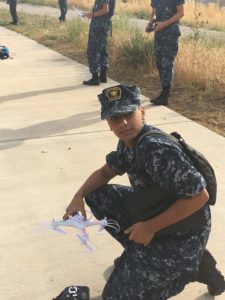Unmanned Aerial Systems Airman Operator Training Course
Description:
This course introduces Cadets to emerging role Unmanned Aircraft Systems (UAS) within the Navy, DoD and Industry. The course is patterned after the actual training curriculum of the Joint Unmanned Aircraft System Minimum Training Standards (JUMTS) and the Basic UAS Qualification (BUQ) Level 1 training required by all service branches to qualify as UAS operators. Cadets will take the same exams as Service members. Accordingly, this is an academically oriented course. Cadets should expect extended class time and five one hour exams.
This course educates cadets on the history, design, operations, safety, regulations, ethics, futures and challenges of the Navy/USMC’s UASs. The course combines classroom instruction and hands-on training, guest lectures and a field trip to Dugway Proving Grounds where Cadets will see up-close Predator, Gray Eagle and Shadow unmanned aircraft and their respective ground stations. Other activities include Leadership Reaction Challenge water obstacle course, tower rappelling and a tactical field training exercise using rubber duck training weapons and UAV overwatch.
Each Cadet will be issued a quadcopter UAV to fly during the training and is theirs to keep. This course is STEM related including important engineering and design skills involving aeronautical design (lift, drag, thrust), plus other science and math related skills with navigation and mission flight plans. Cadets will learn critical safety procedures associated with airspace control, navigation, mission planning, and FAA Visual Flight Rules (VFR). They will learn the importance of team work in the safe and effective use of UAVs and will be exposed to all the exciting careers that are possible in naval aeronautical design associated all classes of UAVs. The course culminates with a “Game of Drones” obstacle course fly-off between squads.
 Mission:
Mission:
This training provides Cadets with the basic components of Group 1 UAVs. It is structured on the same material as the Joint Knowledge On-Line courses. Group 1 UAVs are vehicles of less than 20 pounds and fly lower than 1200 feet above ground level. This course is, by its nature, STEM related including important engineering and design skills involving aeronautical design (lift, drag, thrust), plus other science and math related skills with navigation and mission flight plans. Cadets will learn critical safety procedures associated with airspace control, navigation, mission planning, and FAA Visual Flight Rules (VFR). They will learn the importance of team work in the safe and effective use of UAVs and will be exposed to all the exciting careers that are possible in naval aeronautical design associated all classes of UAVs
Curriculum:
The BUQ curriculum has been designed to meet many learning standards and outcomes. The concepts the cadets learn during the course are indicated below. Parenthesis indicate mirroring to BUQ-1 standard materials from SOCOM-US796 as -01, 02, etc:
- Definition and uses of UASs
- History of the Navy’s Contribution to the Development of UASs (-01)
- UAS system overview (-02)
- Aerodynamics (design and experimentation) (-03)
- Meteorology (-04)
- Crew Resource Management (-05)
- Visual Flight Rules (-06)
- Navigation (-07)
- Airspace Design and Operating Requirements (-08)
- Air Traffic Control Procedures, Rules and Regulations (-09)
- Mission Preparation (-10)
- Emergencies (-11)
- Hands-on Lab experiments and demonstrations
- Guest lectures
Field trips (two full days) to see and learn about military UAVs, leading industry technology developers and academic researchers.
Training Details
-
- Register in Magellan.
-
- Upload NSCTNG001 to Magellan
-
- Escort Officer complete the NSCTNG002 and NSCTNG 025 and upload to Magellan.